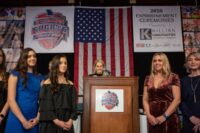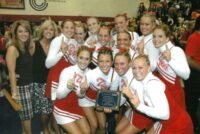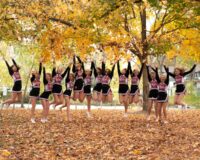Inductees
Ozark High School Cheerleading Program

Stroll through the gym at Ozark High School, look up in the rafters, and it’s an impressive sight. See the state championship banners? The ones for cheerleading?
They certainly aren’t in short supply.
“It was such a cool thing,” former Ozark cheerleading coach Darryl Lyons said. “They did whatever it took to win.”
You could say that they were the talk of the town but, in reality, they’ve also been the talk of the state. That’s why the Missouri Sports Hall of Fame is proud to induct the Ozark High School Cheerleading Program with the Class of 2020.
Having entered the world of competitive cheer back in the 1980s, Ozark struck gold nine times (1997, 2000, 2005, 2006, 2007, 2008, 2011, 2015, 2018), plus earned runner-up finishes in 2010, 2012 and 2014. It also placed third in 2013.
Additionally, Ozark has won regionals 12 times, including every year from 2004 to 2010 (except 2006). Dating back to 1983, 30 members have earned college cheer scholarships.
Competitive cheer at Ozark has roots dating to coach Nita Jackson (1979-1983). She and John Weant, a former College of the Ozarks cheerleader, implemented stunts college-level stunts and co-ed teams. The co-ed teams included football and basketball players in their offseasons and, at one point, they did a pyramid to the gym ceiling. The team grew to 16 on varsity, 10 on JV and eight freshman.
Ozark began competing in 1984 under coach Kim Birkenbaugh.
Since 1994, coaches have been Lyons (Fall 1995 to Spring 2001), Jeanine Atwell (2001-2006), Kristi Romines (2007-2010), Jennifer Clark (2011-2019) and Tess Keller (Spring 2019-current).
Lyons’ arrival came after the closing of a Springfield gym. He had worked there, hoping to expand cheerleading’s footprint in the Ozarks. He had cheered at the University of Arkansas-Little Rock, joined the gym and was part of the National Cheerleaders Association.
“(Ozark) always had strong teams, and at the state tournament, they came close to winning,” Lyons said. “But back then, people (across the area) didn’t even bring in a choreographer.”
With Lyons’ influences from NCA experiences in Dallas and other parts of the South – new choreography, faster routines — Ozark took off. Back-to-back state runner-up finishes fed into the 1997 state title.
“We had great, great chemistry,” Lyons said.
Which became a theme over the next two decades. Well, that and Ozark cheerleaders ramping up their offseason efforts. Many attended tumbling classes to tap into their natural ability to flip, twist, roll and jump.
Atwell inherited a program at a time when the cheerleaders “wanted to be seen as athletes,” she said, noting they trained four days a week, with two days devoted to conditioning.
In her era, Ozark began a run of four consecutive state championships, the first in 2005. The 2005 team executed a nearly flawless routine. The 2006 squad dominated, despite four seniors graduating months earlier.
“It was their doing,” Atwell insisted. “When you have athletes who are excited, it makes you as the coach more excited.”
Still, Atwell took it upon herself to learn about competitive cheer, considering she didn’t cheer during her student years. Attending seminars and speaking with coaches sharpened her coaching.
Another big factor has been cheerleading camps, with roughly 200 girls attending in both the fall and winter.
Romines’ 2007 and 2008 teams won handily at state.
“I had big shoes to fill with Jeanine leaving,” Romines said. “I took over and really pushed the girls. In my mind, I thought, ‘If I don’t win state my first year, I’m going to look bad.’”
“The girls just never quit,” Romines added. “They would do two-a-day practices for two hours each night before regionals and right before state.”
Clark enhanced the program as well. She expanded the varsity roster from 12 annually to between to 16 and 20 cheerleaders.
“The junior high, they kept cranking them out,” said Clark, an elementary school teacher who helped students become interested in cheerleading at an early age. “We did a youth cheerleading camp twice a year. The last year I was there, we had 185 girls.”
The 2011 and 2018 state titles were surprises – 2011 because Ozark had a mistake at the end of its routine; 2018 because of injuries. The 2015 season was almost perfect.
To each coach, support of administrators and parents contributed greatly. Summers were busy, leaving only a two-week window between competition and the start of school.
“There were so many things that went into us being successful,” Atwell said. “The cheerleaders and the families who bought into the program were incredible.”

















